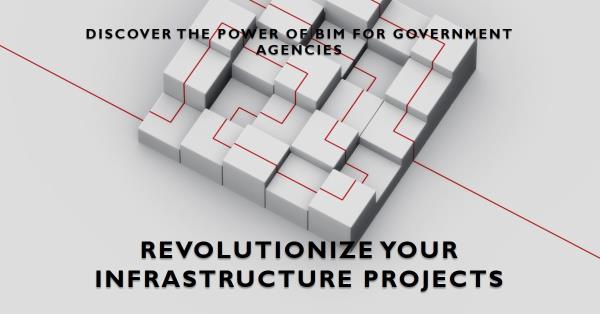As government agencies face increasing demands for efficient and sustainable infrastructure, Building Information Modeling (BIM) has emerged as a crucial tool to meet those challenges. BIM goes beyond traditional design tools by enabling agencies to plan, design, construct, and manage infrastructure projects in a more integrated and efficient manner. By incorporating BIM, government agencies can drive productivity, reduce project timelines, and ensure better resource management.
In this article, we’ll explore how government agencies can leverage BIM for large-scale infrastructure projects, its key benefits, and how companies like Risentech are helping agencies with advanced BIM modeling services and real estate development.
Understanding BIM in the Government Sector
BIM is a process that involves creating and managing digital representations of physical and functional characteristics of a built asset. It provides an intelligent model that encompasses every detail of a project, from design to construction, operation, and eventual demolition.
For government agencies overseeing infrastructure projects, adopting BIM can significantly enhance coordination and decision-making processes. BIM allows stakeholders to work with accurate data in real time, ensuring alignment across various disciplines involved in a project, such as architects, engineers, and contractors.
Key Benefits of BIM for Government Infrastructure Projects
1. Improved Project Efficiency
Large-scale infrastructure projects often require collaboration among multiple stakeholders, each with distinct roles and responsibilities. BIM enables these parties to collaborate more efficiently through a shared digital platform. According to the McKinsey Global Institute, using digital tools like BIM can reduce construction project costs by 20%, as it enables better coordination and faster completion of tasks.
With the integration of 3D models, government agencies can avoid costly errors, as potential issues can be identified and resolved early in the design process. This efficiency also translates into faster approvals and smoother workflows.
2. Enhanced Cost Management
One of the most significant challenges in public infrastructure projects is cost overruns. BIM helps agencies manage costs effectively by providing detailed insights into material quantities, labor needs, and other resource requirements at each stage of a project. The National Building Information Modeling Standard Project Committee estimates that the use of BIM can reduce overall project costs by up to 15%. This is because BIM improves forecasting accuracy, reducing the likelihood of unexpected expenses.
Government agencies can also track the ongoing costs of operation and maintenance with the help of BIM, enabling better long-term budget planning.
3. Sustainability and Energy Efficiency
Sustainability is a growing concern for public sector projects, as agencies aim to reduce their environmental footprint. BIM allows agencies to simulate energy use, material consumption, and environmental impact during the early stages of design. By leveraging this data, agencies can develop infrastructure projects that are more energy-efficient and eco-friendly.
Moreover, BIM facilitates the use of sustainable materials, better waste management, and lower carbon emissions. This focus on sustainability aligns with government objectives for greener, more responsible infrastructure development.
4. Improved Asset Management
Once an infrastructure project is completed, government agencies are responsible for maintaining the asset throughout its lifecycle. BIM plays a critical role in asset management by enabling agencies to access detailed information about the structure, including materials used, maintenance schedules, and energy consumption.
This digital record can significantly reduce the time and cost associated with asset management, as facility managers can track maintenance needs and address issues proactively. For example, the UK government reported a 33% savings on lifecycle costs for public projects utilizing BIM for asset management.
5. Better Risk Mitigation
BIM’s ability to detect potential design conflicts early in the planning stages minimizes the risk of costly delays during construction. Additionally, it helps in assessing the safety and stability of infrastructure projects by running simulations on various scenarios. This reduces the likelihood of safety issues during construction and throughout the lifecycle of the asset.
Government agencies can also use BIM to ensure compliance with building codes and regulations, further mitigating the risks of project delays and fines.
Case Study: How BIM Transformed a Large-Scale Public Infrastructure Project
A great example of BIM’s benefits can be seen in the development of London’s Crossrail, a massive public transportation project. Crossrail adopted BIM at every stage of the project, from design to operation. The result? An estimated 20% reduction in costs and a highly integrated approach that allowed the team to collaborate more effectively across various disciplines.
BIM enabled the project team to foresee potential clashes in design, improve resource allocation, and streamline the construction process. Additionally, BIM data is now used in the asset management of Crossrail’s infrastructure, ensuring long-term operational efficiency.
How Risentech Supports Government Agencies with BIM Services
At Risentech, we understand the challenges that government agencies face when managing large-scale infrastructure projects. With our expertise in BIM modeling services, we help agencies improve project efficiency, minimize costs, and ensure long-term sustainability. Whether it’s enhancing collaboration between stakeholders or optimizing real estate development, Risentech offers comprehensive solutions tailored to government needs.
Our team of experts uses the latest BIM technologies to provide government agencies with detailed digital models that ensure accuracy and reliability throughout the project’s lifecycle.
FAQs About BIM for Government Infrastructure Projects
1. What types of infrastructure projects benefit most from BIM?
BIM is particularly beneficial for large-scale projects such as transportation systems, bridges, tunnels, public buildings, and utilities infrastructure. These projects involve numerous stakeholders and complex designs that require efficient collaboration.
2. How can government agencies start implementing BIM?
Government agencies can start by ensuring all stakeholders are trained in BIM software and processes. They should also work with a BIM consultant to develop a strategy tailored to their specific project needs and goals.
3. Can BIM help reduce the environmental impact of public infrastructure projects?
Yes, BIM allows agencies to analyze the environmental impact of a project early in the design phase. This enables the selection of more sustainable materials, efficient energy use, and reduced waste.
4. Is BIM cost-effective for small-scale projects?
While BIM is most advantageous for large-scale projects, it can also benefit smaller projects by improving design accuracy and reducing errors. However, the cost-effectiveness of BIM for smaller projects will depend on the project’s complexity and budget.
5. What are the long-term benefits of using BIM for public assets?
BIM provides a detailed record of the entire infrastructure asset, including materials, maintenance history, and performance data. This ensures efficient asset management and reduced operational costs over the asset’s lifecycle.
Conclusion
Building Information Modeling (BIM) has proven to be a game-changer for government agencies managing large-scale infrastructure projects. By improving collaboration, cost management, sustainability, and asset management, BIM offers a pathway to more efficient and innovative public projects. With the right tools and expertise, agencies can significantly enhance the delivery and management of infrastructure.
Are you ready to leverage BIM to transform your next infrastructure project?
Also know Optimizing Architectural Services for Smart Cities & IoT Integration








